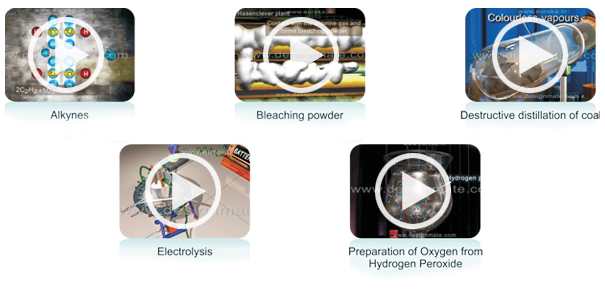





Chemistry:

Prices:
|
 |
Sample Demos:
High Bandwidth Demos

Low Bandwidth Demos

List of Topics:
The following section gives a high level overview of the subjects covered. If you wish to get a detailed listing of the actual topics covered, please contact us atPhone: 609 750-9827
Email: info@staminteractive.com
INDUSTRIAL CHEMISTRY
Total Topics : 23 | Total Duration: 01.09.32Topic name
Duration1. Bleaching Powder
00.05.322. Compressed natural gas (CNG)
00.04.163. Manufacturing of steel (Bassemer converter)
00.03.134. Extraction of iron
00.02.045. Natural rubber
00.00.596. Cement
00.01.267. Contact process for the manufacture of sulphuric acid
00.08.178. Haber Process (manufacture of Ammonia)
00.02.309. Industrial preparation of Hydrogen
00.03.0710. Ostwald’s Process (Manufacturing of dilute nitric acid)
00.03.0211. Solvay process (manufacture of washing soda)
00.04.2412.Extraction of silver
00.00.5213. Extraction of mercury
00.00.47Metallurgy
Topic name
Duration1. Hoope’s process for refining aluminum
00.01.562. Alloys and their uses
00.04.173. Metallurgy
00.01.594. Allotropic forms of phosphorous
00.03.375. Chemical Properties of phosphorous
00.03.326. Lead
00.00.40Equipment
Topic name
Duration1. Fire extinguishers
00.01.38Techniques
Topic name
Duration1. Catalytic Converter
00.06.192. Photo-oxidation
00.03.393. Methods to raise octane number
00.01.26INORGANIC CHEMISTRY
Total Topics : 106 | Total Duration: 04.40.51Topic name
Duration1. Carbon monoxide (CO)
00.01.032. Preparation of Carbon dioxide
00.01.483. Destructive distillation of coal
00.02.474. Difference between diamond and graphite
00.04.395. Destructive distillation of wood
00.01.116. Soot
00.00.547. Fullerene
00.01.238. Charcoal
00.01.209. Chemical properties of carbon dioxide
00.04.3110. Introduction (carbon compounds)
00.01.0211. Occurrence of carbon
00.00.4712. Chemical properties of carbon
00.02.07Metals and non-metals
Topic name
Duration1. Corrosion
00.04.212. Reaction of metals with water
00.02.353. Reaction of metallic oxide with water
00.02.584. Physical properties of alkali metals
00.03.495. Reaction of metals with chlorine
00.01.096. Chemical properties of metals
00.01.167. Uses of metals and non metals
00.02.388. Conduction of electricity
00.02.379. The relative Reactivity’s of metals
00.01.2910. Methods of preventing corrosion
00.04.2311. Actinide series
00.00.5412. Reaction of metal oxides with acid
13. Chemical properties of alkali metal elements and their uses
00.03.5114. Flame test
00.01.3215. Reaction of metals with oxygen
00.04.4416. Reaction of metals with hydrogen
00.01.0617. Silver nitrate (AgNo3)
00.01.0518. Silver halides
00.03.03Hydrogen
Topic name
Duration1. Hydrogen
00.01.222. Position of hydrogen in the periodic table
00.01.243. Chemical properties of Hydrogen
00.03.214. Physical properties of hydrogen
00.01.335. Classification of hydrides
00.02.076. Hydrogen Economy
00.00.507 Isotopes of Hydrogen
00.01.448. Hydrogen spectrum
00.06.209. Uses of hydrogen
00.02.46Co-ordinate compounds
Topic name
Duration1. IUPAC nomenclature of complexes
00.04.292. Geometry of K3 [Fe (CN) 6]
00.03.513. Geometry of [Co (NH3) 6] 2+
00.04.204. Geometry of [Fe (H2O) 6] 3+
00.02.015. Geometry of [K4(CN6)]
00.02.026. Tetrachloro nickelate II (Ni Cl4)2-
00.01.377. Coordination number and geometry of complexes
00.02.418. Coordination compounds
00.02.139. SP3d2 Hybridization in SF6
00.01.2810. Classification of ligands
00.03.26P – Block elements
Topic name
Duration1. Carbon
00.02.342. Carbon dioxide
00.02.233. Structure of ozone and its importance
00.01.494. Chemical properties of dilute sulphuric acid
00.01.575. Physical properties of sulphuric acid
00.02.136. Physical properties of sulphur dioxide
00.01.297. Reaction of sulphur with metals
00.03.378. Chemical reactivity of nitrogen
00.01.479. Sulphur
00.02.2810. Chemical properties of sulphur dioxide I
00.06.4911. Chemical properties of sulphur dioxide II
00.05.0112. Experiment to demonstrate properties of charcoal
00.02.2813. Preparation of oxygen from hydrogen peroxide
00.01.1114. Physical properties of ammonia
00.02.2915. Sulphur dioxide and its uses
00.01.0316. Stability towards heat and solubility of oxo compounds
00.01.4617. Properties of Phosphines
00.00.3918. Sulphuric acid
00.01.3919. Uses of sulphuric acid
00.00.3620. Ammonia and its uses
00.02.0621. Carbides
00.03.5622. Compounds of phosphorous
00.00.59S – Block elements
Topic name
Duration1. Diagonal relation of beryllium with aluminium
00.02.202. Magnesium
00.03.243. Calcium hydroxide
00.02.244. Compounds of sodium
00.03.435. Reaction of sodium bicarbonate with hydrochloric acid
00.01.08Periodic Table
Topic name
Duration1. Metallic and non-metallic properties in a period
00.01.552. Mendeleev’s periodic law
00.03.533. Newland's law of octaves
00.01.084. Dobereiner's law of triads
00.01.305. Modern periodic table
00.12.426. Oxidation states and periodic table II
00.03.037. Oxidation states and periodic table I
00.03.588. Ionization energy
00.02.129. Electron affinity
00.03.5510. Factors affecting magnitude of electron affinity
00.05.0811. Atomic size and ionization potential (transition element)
00.01.4012. Atomic radius
00.05.1213. Orbits and Orbitals
00.06.16Transition Elements
Topic name
Duration1. Electron Configurations of transition metal elements
00.03.552. Oxidation states (Transition elements)
00.03.423. Lanthanide Series
00.00.264. Lanthanide Contraction
00.00.585. Colour of complex compounds
00.01.586. Geometrical and Optical isomerism in complex compounds
00.03.567. Oxidation states (Lanthanides)
00.01.248. Tendency of the transition metal ions to form complexes
00.02.599. Catalytic property
00.01.4010. Potassium dichromate (K2Cr2O7)
00.02.35Water
Topic name
Duration1. Effects of hard water
00.01.152. EDTA Titration Method
00.03.303. Water as a solvent
00.05.104. Deionization of water
00.02.555. Self ionization of water
00.02.556. Method to remove permanent hardness in water
00.06.227. Heavy water
00.00.47ORGANIC CHEMISTRY
Total Topics : 81 | Total Duration: 03.22.06Topic name
Duration1. Industrial production of ABS and LAS
00.01.512. Cleansing action of soaps and detergents
00.06.263. Soaps and detergent
00.03.344. Anionic detergents
00.00.43Alcohols and ethers
Topic name
Duration1. Industrial Production of Ethanol
00.01.052. Ethers
00.01.493. Electrophilic substitution in alkly aryl ethers
00.01.264. Production of ethanol
00.05.435. Properties of ethanol
00.06.036 Alcohols and their classification
00.01.49Aromatic Hydrocarbons
Topic name
Duration1. Huckel's rule
00.01.232. Reimer-Tiemann reaction
00.00.333. Polynuclear hydrocarbons and their toxicity
00.00.554. Mono and disubstituted derivatives of benzene
00.04.145. Fries rearrangement
00.00.366. Aromatic Hydrocarbons (Arenes)
00.01.027. Chlorination of benzene
00.01.578. Sulphonation of benzene
00.02.139. Directing groups and their directive effects
00.02.1810. Alkylation of benzene
00.02.1911. Acylation of benzene
00.01.2912. Nitration of benzene
00.01.4913. Heat of Hydrogenation and resonance in Benzene
00.05.26Carbonyl compounds
Topic name
Duration1. Electronic structure of carboxylic acid
00.00.332. Classification of carbonyl compounds
00.01.493. Aldol condensation
00.05.034. Properties of carboxylic acid
00.02.585. Chemical Properties of carboxylic acid
00.02.166. Physical properties of aldehydes and ketones
00.03.537. Methane
00.01.568. Preparation of propanone
00.00.45Drugs and dyes
Topic name
Duration1 Direct dyes
00.00.272 Disperse dyes
00.00.313. Basic dyes
00.00.31Fibers and Polymers
Topic name
Duration1 Properties of polymers
00.02.542 Butyl Rubber
00.00.373 Polymerization reaction
00.01.454 Polymers
00.02.335. Addition polymerization (Free radical addition polymerization)
00.03.066. Condensation polymer
00.02.067. Polythene
00.01.038. Polyvinyl chloride (PVC) & polystyrene
00.01.379. Coordination polymerization and ziegler- natta catalyst
00.03.5410. Ionic addition Polymerization
00.04.5211. Bakelite
00.01.14Compounds containing functional group with nitrogen
Topic name
Duration1. Separation of primary, secondary and tertiary amines
00.01.162. Hoffmann reaction
00.02.033. Isocyanide compounds
00.01.41Hydrocarbons
Topic name
Duration1. General methods of preparation of alkene
00.01.282. Reactions of Alkanes
00.01.533. Organic compounds
00.02.024. IUPAC Nomenclature (II) - Nomenclature of branched alkanes
00.08.185. Nomenclature and isomerism
00.02.096. Structural isomerism in alkanes
00.03.277. Diene Compounds
00.01.288. Re-arrangement reaction
00.00.469. Geometrical isomerism in Hydrocarbons
00.05.3810. Addition reaction of alkenes
00.03.1711. Alkynes
00.05.0212. Nomenclature and properties of geometric isomers
00.05.36Halides
Topic name
Duration1. Classification of alkyl halides
00.02.392. Nucleophilic Substitution Reactions of Organic Halides
00.02.583. Properties of organic Halides
00.04.12Nomenclature
Topic name
Duration1. Nomenclature of aldehydes and ketones
00.02.412. Classification of functional groups I
00.01.353. Classification of functional groups II
00.02.544. Nomenclature of amines
00.02.405. IUPAC Nomenclature (I)
00.01.48Stereochemistry
Topic name
Duration1. Configuration and conformation
00.01.012. Conformational analysis in ethane
00.03.433. Conformational analysis in propane
00.00.384. Conformational analysis in butane
00.01.465. Conformational analysis in cyclohexane
00.01.496. Fischer projection formula
00.01.047. Absolute configuration
8. Enantiomers, meso forms and diastereoisomers
00.04.579 Chirality and Molecular asymmetry
00.03.0410 Origin of chirality
00.01.3211 Enantiomers and distereoisomers
00.01.13Oxides
Topic name
Duration1. Simple oxides of Metals and Non-Metals
00.04.322. Uses of oxides of metals and non metals
00.03.54PHYSICAL CHEMISTRY
Total Topics : 182 | Total Duration: 09.09.20Topic name
Duration1. Acids, bases and salts
00.06.102. Indicators
00.07.013. Strong and weak acid
00.02.244. PH scale
00.03.495. Limitations of PH scale
00.02.036. Basic buffer
00.04.447. Neutralization
00.02.588. Acids bases titrations
00.01.299. Acidic Buffer
00.06.0910. Arrhenius theory of acids & bases
00.05.2111. Lowry-Bronsted theory acids and bases
00.06.1712. Lewis theory of acids and bases
00.04.4013. Reaction of metal carbonates with acids
00.02.2114. Solubility and saturation
00.03.2115. Classification of salts
00.05.1816. Ionization of acids and bases
00.01.3317. Bases in some materials
00.01.32Atoms, ions and molecules
Topic name
Duration1. What is an atom?
00.01.332. Valency
00.06.073. Electron sea model
00.00.464. Molecular formula
00.03.475. Constitution of atomic nucleus
00.01.586. Electronic configuration of elements
00.06.217. Variable Valency
00.03.018. Modern Atom
00.02.309. Rutherford’s atomic model
00.02.3610. Bohr's atom model
00.05.4411. Concentration of solution
00.02.3912. Radicals
00.00.3413. Valence bond theory
00.02.4314. VSEPR theory
00.04.00Basic concepts of chemistry
Topic name
Duration1. Names and formulae of simple compounds
00.00.432. Formulae of compound (Using Valancies)
00.02.343. Balancing of equations
00.02.384. Chemical equation
00.02.375. Chemical formulae
00.01.206. Mass percentage of an element
00.01.407. Empirical formula
00.02.14Bonding
Topic name
Duration1. Hydrogen bonding
00.06.082. Types of Hydrogen bonding
00.01.053. Significance of hydrogen bonding
00.02.314. Chemical bond in hydrogen molecule
00.01.255. Vander walls Forces (Intermolecular Forces)
00.03.526. Types of van der waals forces
00.04.557. Structure of silicon dioxide and carbon dioxide
00.05.598. Fission of a covalent bond
00.06.469. Metallic Bonding
00.07.0810. Polarity of bonds
00.04.5111. Resonance structure
00.02.2312. Electronic substitution in covalent bond
00.02.1413. Energy changes in formation of covalent bond
00.01.1614. Molecular solids
00.00.5915. Electrovalent or ionic compounds and its properties
00.03.4416. Brittleness in ionic crystals
00.01.0817. Formation of covalent molecules or compounds
00.02.5618. Ionic crystals and their properties
00.04.1819. Bond order
00.01.1320. Hybridization of atomic orbitals
00.03.0421. Chemical bonding
00.05.4322. Electrovalent bond (Ionic bond)
00.03.3023. Covalent bond or Molecular bond
00.04.1224. Coordinate bond
00.02.4125. Polar and non polar covalent Bonds
00.03.1126. Types of covalent bond and lewis representation
00.03.1827. Difference between Electrovalent (ionic) and covalent compounds
00.08.59Changes
Topic name
Duration1. Changes around us- I
00.04.582. Changes around us- II
00.03.343. Desirable and undesirable changes
00.02.15Chemical equilibrium
Topic name
Duration1. Requirements of equilibrium state
00.00.592. Characteristics of equilibrium constant
00.01.163. Effect of Pressure on Equilibrium
00.01.194. Le Chatelier's principle
00.02.365. Shifting of equilibrium on changing Temperature
00.01.006. Equilibrium constant of calcium carbonate
00.04.067. Acid Dissociation equilibrium constant Ka
00.02.298. Base Dissociation equilibrium constant Kb
00.02.139. Types of equilibrium
00.02.15Chemical kinetics
Topic name
Duration1. Activation energy
00.07.302. Kinetic molecular theory of gases
00.01.203. Rates of reaction and concentrations
00.02.474. Effect of a catalyst on equilibrium
00.01.195. Molecularity
00.01.176. Reaction involving slow steps
00.01.497. Ether formation from alkyl halides
00.01.268. Rate of Reaction
9. Redox reaction
00.00.5410. Integrated rate law of first order reaction
00.02.4411. Oxidation numbers
00.04.09Chemical reaction
Topic name
Duration1. Combination reaction
00.02.382. Decomposition reaction
00.01.553. Displacement reaction
00.02.444. Double decomposition reaction
00.02.415. Chemical reaction
00.01.156. Chemical Reaction and their Characteristic
00.04.007. Elimination reaction
00.00.35Colligative properties
Topic name
Duration1. Degree of dissociation
00.02.122. Molal depression measurement method
00.00.473. Degree of association
00.01.444. Colligative properties of solution
00.02.065. Van't hoff factor i
00.03.096. Depression of freezing point and molecular weight
00.04.18Electrochemistry
Topic name
Duration1. Standard hydrogen electrode
00.01.232. Use of standard hydrogen electrode as an anode
00.05.513. Applications of electrolysis I
00.03.504. Applications of electrolysis II
00.05.595. Electrical resistance
00.01.396. Electrolytes
00.01.327. Electrolysis of water
00.03.528. Factors affecting product of electrolysis I
00.04.279. Factors affecting product of electrolysis II
00.06.0910. Solutions and their properties
00.02.1511. Electrolysis
00.05.1412. Acid solutions conduct electricity
00.01.4613. The dry cell
00.01.0314. Difference between electrochemical and electrolytic cell
00.01.5615. Differences between conductors and electrolytes
00.01.1616. Oxidation reduction and electron transfer method
00.01.0917. Lead acid storage battery
00.04.4618. Conduction of electricity in water
00.00.47Elements and compounds
Topic name
Duration1. Compounds
00.00.58Nuclear Chemistry
Topic name
Duration1. Isotopes
00.01.47Osmosis
Topic name
Duration1. Osmotic pressure measurement method
00.00.54Rate of reaction
Topic name
Duration1. Factors affecting rate of reactions
00.07.01States of matter
Topic name
Duration1. Structure of simple ionic compound
00.02.072. Effect of change in pressure on the state of matter
00.04.103. Changes in the state of matter
00.01.094. Liquid crystal
00.04.155. Diffusion
00.02.506. Graham’s Law of Diffusion of Gases
00.03.227. States of matter
00.03.188. Properties of different states of matter
00.06.369. Arrangement and diffusion of molecules in solids, liquids and gases
00.02.5310. Changeable states of matter
00.03.0211. Effect of change in temperature on the state of matter
00.05.25Uses of some compounds
Topic name
Duration1. Uses of oxygen
00.03.152. Uses of steel
00.01.34Properties of some compounds
Topic name
Duration1. Chemical properties of conc. sulphuric acid
00.03.152. Lime (Cao)
00.00.393. Reaction between baking soda and vinegar
00.01.354. Properties of material
00.07.57Crystal structure
Topic name
Duration1. Atomic imperfections
00.03.282. Cubic close - packed structure
00.03.073. MX type of ionic compounds
00.01.27Structure of atom
Topic name
Duration1. Aufbau principle
00.02.162. Quantum numbers
00.05.52Thermodynamics
Topic name
Duration1. Spontaneous processes
00.01.372. Basic concepts of thermodynamics -II
00.03.153. Coffee cup calorimeter
00.04.06Nuclear Chemistry
Topic name
Duration1. Application of isotopes
00.02.042. Isobars
00.02.033. Canal rays
00.01.28Mixtures
Topic name
Duration1. Mixtures
00.03.362. Properties of a Colloids
00.03.083. Suspensions and their properties
00.03.264. Preparation of colloidal solution II
00.04.225. Preparation of Colloidal Solution I
00.03.326. Solid liquid mixture
00.04.337. Types of solutions
00.02.518. Evaporation(Mechanism)
00.01.499. Vapour pressure of a solvent
00.01.5910. Factors affecting vapour pressure of solvent
00.02.5211. Sublimation
00.01.1712. Centrifugation
00.02.0513. Distillation
00.01.3414. Liquid - gas mixture
00.01.5715. Separation of dye in black ink using chromatography
00.02.1316. Separating the rare gases form air (Ramsay’s experiment)
00.02.5617. Crystallization
00.01.4318. Evaporation
00.01.2019 Solid solution
00.01.0320 Liquid –Liquid mixture
00.04.13Energy
Topic name
Duration1. Solar Cells
00.05.382. Solar cooker
00.06.233. Wind energy
00.03.394. Windmills
00.07.025. Flames
00.04.566. Nuclear energy
00.01.047. Renewable sources of energy
00.02.068. Combustion and its types
00.01.48Fuels
Topic name
Duration1. Octane number of gasoline
00.01.21Laboratory preparation of compounds
Topic name
Duration1. Laboratory preparation of Hydrogen
00.01.312. Laboratory preparation of oxygen
00.03.00ENVIRONMENTAL CHEMISTRY
Total Topics : 08 | Total Duration: 00.21.02Topic name
Duration1. Structure of the Earth
00.01.462. Water Vapor
00.01.173. Life on earth
00.03.464. Dust And Smoke
00.00.555. Air
00.01.596. Composition of air
00.03.21Pollution
Topic name
Duration1. Causes of air pollution
00.02.542. Acid rain
00.05.04


